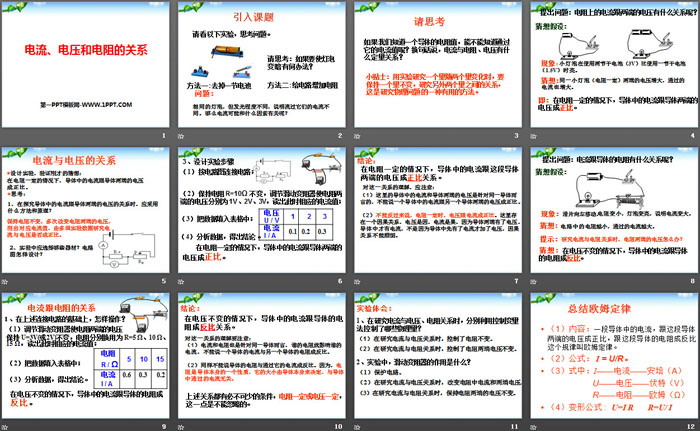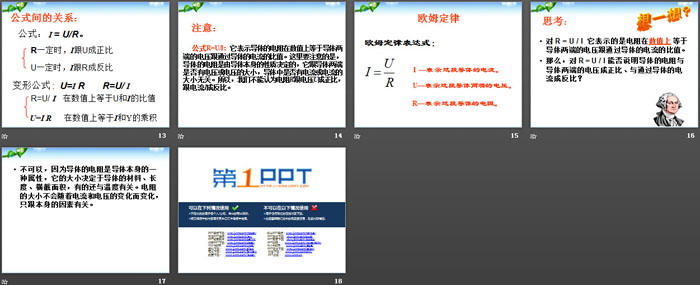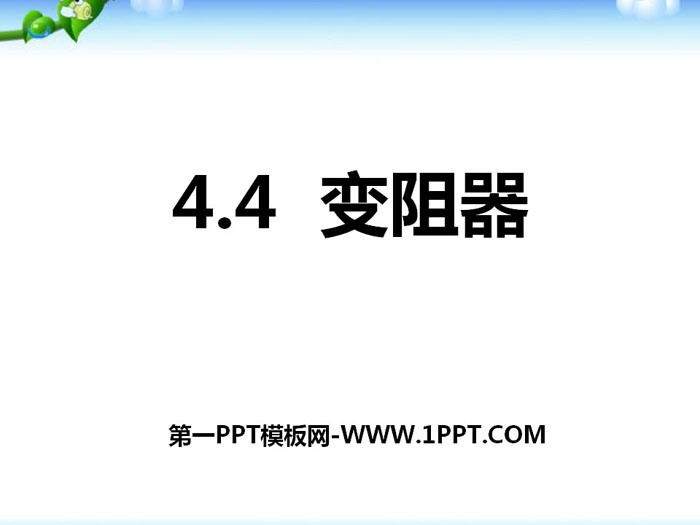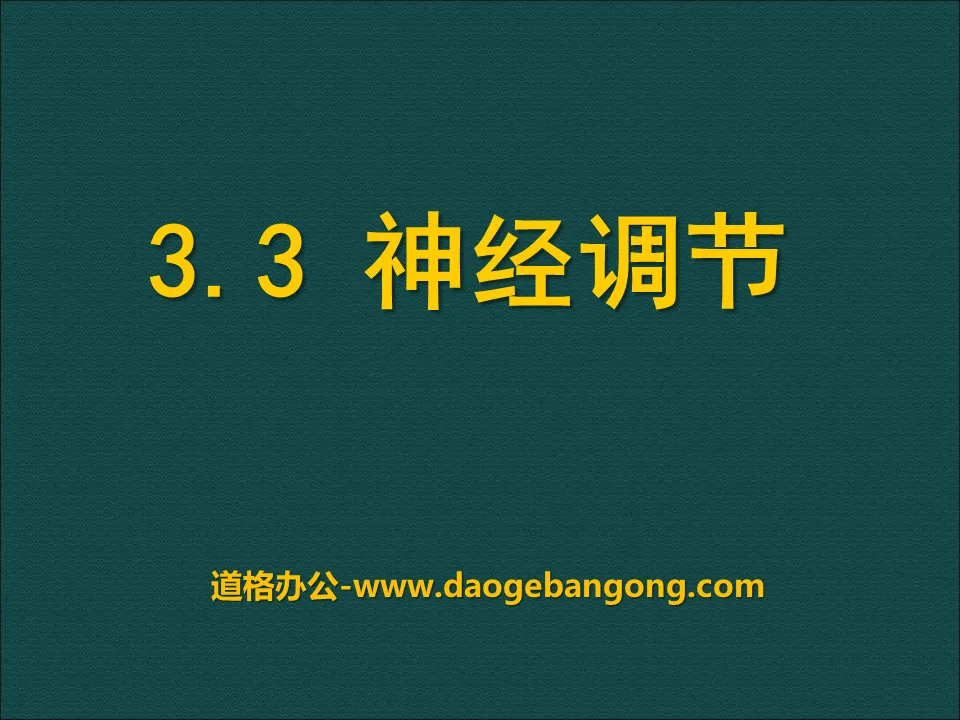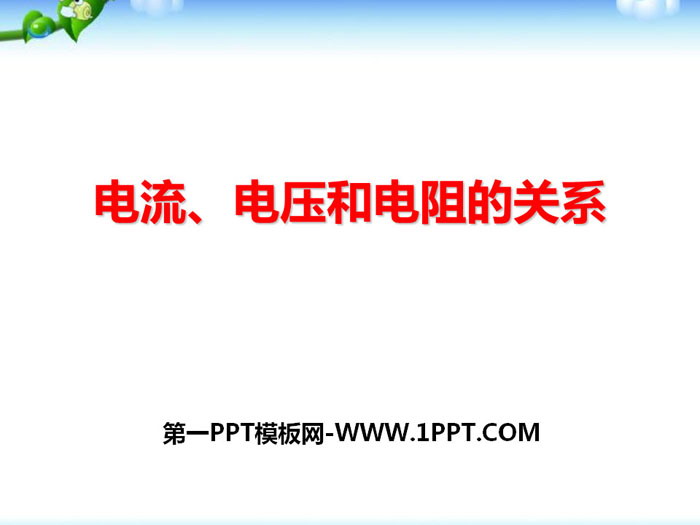
| Category | Format | Size |
|---|---|---|
| Zhejiang Education Edition Eighth Grade Science Volume 1 | pptx | 6 MB |
Description
"The Relationship between Current, Voltage and Resistance" PPT courseware
Part One: Introduction to the topic
Please look at the following experiment and think about the problem.
Please think: What can be done to dim the light bulb?
Method 1: Remove one battery
Method 2: Add resistance to the circuit
question:
The same light bulbs emit different amounts of light, indicating different currents flowing through them. Which current may be related to what factors?
please think
If we know the resistance of a conductor, can we know the current flowing through it? In other words, what is the quantitative relationship between current, resistance, and voltage?
Tips: When using experiments to study the change of one quantity with two quantities, keep one quantity constant and study the relationship between the other two quantities. This is a useful method for studying physical problems.
The relationship between current, voltage and resistance PPT, Part 2: The relationship between current and voltage
Design experiments to verify the conjecture just now:
When the resistance is constant, the current in the conductor is proportional to the voltage across the conductor.
think:
1. When exploring the relationship between the current in a conductor and the voltage across the conductor, what methods and principles should be used?
Keep the resistance constant, change the voltage across the resistor multiple times, measure the corresponding current value, and use multiple sets of experimental data to study whether the current and voltage are proportional.
2. What equipment should be selected in the experiment? How to design a circuit diagram?
3. Design experimental steps
(1) Connect the circuit according to the circuit diagram;
(2) Keep the resistance R=10Ω unchanged, adjust the sliding rheostat so that the voltages at both ends of the resistor are 1V, 2V, and 3V respectively, and read the corresponding current values at this time;
(3) Fill in the data into the form;
(4) Analyze data and draw conclusions.
When the resistance is constant, the current in the conductor is proportional to the voltage across the conductor.
The relationship between current, voltage and resistance PPT, the third part: the relationship between current and resistance
1. How to operate based on the above connection circuit?
(1) Adjust the sliding rheostat so that the voltage across the resistor
Keep U=3V (or 2V) unchanged, change the resistors to R=5 Ω, 10 Ω, and 15 Ω respectively, and read the corresponding current values at this time;
(2) Fill in the data into the form;
(3) Analyze data and draw conclusions.
When the voltage remains constant, the current in a conductor is inversely proportional to the resistance of the conductor.
in conclusion:
When the voltage remains constant, the current in a conductor is inversely proportional to the resistance of the conductor.
To understand this relationship, please note:
(1) Current and resistance are also for the same conductor. Whoever's resistance affects the current. It cannot be said that the current of one conductor is inversely proportional to the resistance of another conductor.
(2) It cannot be said that the resistance of a conductor is inversely proportional to the current flowing through it. Because resistance is a property of the conductor itself, its size is determined by the conductor itself and has nothing to do with the current passing through the conductor.
The above relationships all have essential conditions, such as a certain resistance or a certain voltage, which cannot be ignored.
Experimental experience:
1. When studying the relationship between current, voltage, and resistance, what physical quantities are controlled by the control variable method?
(1) When studying the relationship between current and voltage, the resistance is controlled to be constant.
(2) When studying the relationship between current and resistance, the voltage across the resistor was controlled to remain unchanged.
2. In the experiment, what is the function of the sliding rheostat?
(1) Protection circuit.
(2) When studying the relationship between current and voltage, change the current in the resistor and the voltage at both ends.
(3) When studying the relationship between current and resistance, keep the voltage across the resistor constant.
PPT on the relationship between current, voltage and resistance, Part 4: Summary of Ohm’s Law
(1) Content: The current in a conductor is directly proportional to the voltage across the conductor and inversely proportional to the resistance of the conductor. This law is called Ohm's law.
(2) Formula: I = U/R.
(3) In the formula: I—current—ampere (A)
U—Voltage—Volt (V)
R—resistance—ohm (Ω)
(4) Deformation formula: U=I R R=U/ I
Relationship between formulas:
Formula: I = U/R.
When R is constant, I is proportional to U
When U is constant, I is inversely proportional to R
Deformation formula: U=I R R=U/ I
R=U/I is numerically equal to the ratio of U and I
U=I R is numerically equal to the product of I and Y
Notice:
Formula R=U/I: It means that the resistance of a conductor is numerically equal to the ratio of the voltage across the conductor to the current through the conductor. What should be noted here is that the resistance of a conductor is determined by the properties of the conductor itself. It has nothing to do with whether there is voltage or the magnitude of the voltage at both ends of the conductor, or whether there is current or the magnitude of the current in the conductor. Therefore, we cannot think that the resistance R is directly proportional to the voltage U and inversely proportional to the current I.
PPT on the relationship between current, voltage and resistance, part 5 content: Thinking:
For R = U / I it means that the resistance is numerically equal to the ratio of the voltage across the conductor to the current through the conductor.
So, for R = U / I, can it be said that the resistance of a conductor is directly proportional to the voltage across the conductor and inversely proportional to the current through the conductor?
No, because the resistance of a conductor is an attribute of the conductor itself. Its size depends on the material, length, cross-sectional area of the conductor, and some are also related to temperature. The size of the resistance will not change with changes in current and voltage, but is only related to its own factors.
Keywords: Zhejiang Education Edition eighth grade science PPT courseware free download, relationship between current, voltage and resistance PPT download, .PPT format;
For more information about the "Relationship between Current, Voltage and Resistance" PPT courseware, please click on the "Relationship between Current, Voltage and Resistance" PPT tab.
"The Relationship between Current, Voltage and Resistance" PPT:
"The Relationship between Current, Voltage and Resistance" PPT Part 1 content: Thinking: Which physical quantity is most susceptible to the magnitude of the current passing through a certain conductor in a certain circuit, the voltage at both ends of this conductor, and the resistance of this conductor? Due to changes in quantity...
File Info
Update Time: 2024-07-01
This template belongs to science courseware Zhejiang Education Edition Eighth Grade Science Volume 1 industry PPT template
"The Relationship between Current, Voltage and Resistance" PPT courseware Simple campus recruitment activity planning plan summary enterprise and institution recruitment publicity lecture PPT template is a general PPT template for business post competition provided by the manuscript PPT, simple campus recruitment activity planning plan summary enterprise and institution recruitment promotion Lecture PPT template, you can edit and modify the text and pictures in the source file by downloading the source file. If you want more exquisite business PPT templates, you can come to grid resource. Doug resource PPT, massive PPT template slide material download, we only make high-quality PPT templates!
Tips: If you open the template and feel that it is not suitable for all your needs, you can search for related content "The Relationship between Current, Voltage and Resistance" PPT courseware is enough.
How to use the Windows system template
Directly decompress the file and use it with office or wps
How to use the Mac system template
Directly decompress the file and use it Office or wps can be used
Related reading
For more detailed PPT-related tutorials and font tutorials, you can view: Click to see
How to create a high-quality technological sense PPT? 4 ways to share the bottom of the box
Notice
Do not download in WeChat, Zhihu, QQ, built-in browsers, please use mobile browsers to download! If you are a mobile phone user, please download it on your computer!
1. The manuscript PPT is only for study and reference, please delete it 24 hours after downloading.
2. If the resource involves your legitimate rights and interests, delete it immediately.
3. Contact information: service@daogebangong.com
"The Relationship between Current, Voltage and Resistance" PPT courseware, due to usage restrictions, it is only for personal study and reference use. For commercial use, please go to the relevant official website for authorization.
(Personal non-commercial use refers to the use of this font to complete the display of personal works, including but not limited to the design of personal papers, resumes, etc.)
Preview

